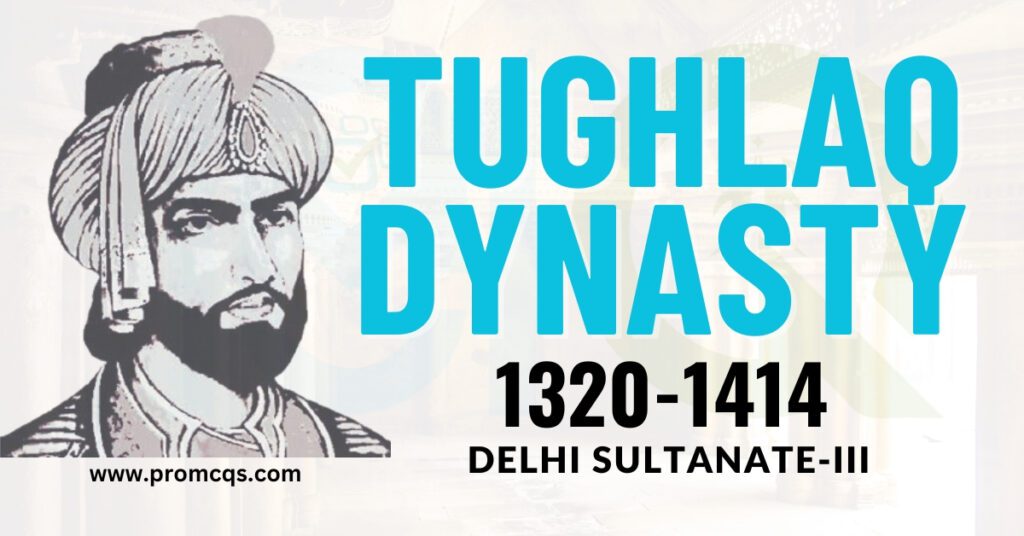Tughlaq Dynasty was a Turk-Indian family which ruled as the Delhi Sultanate-III about 93 years. The Dynasty came into existence after the death of Nasir-ud-Din in 1320 AD by Ghazi Malik. At that time Ghiyas-ud-Din Tughlaq was the governor of the northwest provinces during the reign of Khusrav Shah. He ascended the throne and start ruling in Delhi.
Important Tughlaq Dynasty Rulers
| Ruler | Reign |
|---|---|
| Ghiyas-ud-din Tughlaq | 1320-1325 AD |
| Muhammad Bin Tughlaq | 1325-1351 AD |
| Feroze Shah Tughlaq | 1351-1388 AD |
| Ghiyas-ud-din Tughlaq Shah II | 1388-1389 AD |
| Abu Bakr Shah | 1389-1390 AD |
| Nasir-ud-din Muhammad Tughlaq | 1390-1394 AD |
Syed Khizar Khan in 1414 AD laid the foundation of Sayyid Dynasty.
Important Tughlaq Dynasty MCQs for different Competitive Exams
Who was the founder of Tughlaq Dynasty?
a. Ghiyas-ud-Din Tughlaq
b. Firoz Shah Tughlaq
c. Muhammad Bin Tughlaq
d. None of these
For how many years Tughlaq family ruled on Delhi?
a. 89
b. 93
c. 100
d. 101
Ghiyas-ud-Din Tughlaq was died on?
a. 1325 AD
b. 1326 AD
c. 1327 AD
d. 1329 AD
Who was the successor of Ghiyas-ud-Din Tughlaq?
a. Muhammad Bin Tughlaq
b. Khizar Khan
c. Feroz Shah
d. Abu Bakr Shah
Which of the following important taxes were collected by Firoz Shah?
a. Khams
b. Jizya
c. Zakat
d. Kharaj
e. All of these
Tughlaqabad Fort construction was started by ?
a. Ghazi malik
b. Nasir-ud-Din Muhammad Tughlaq
c. Timur Ling
d. Sher Shah Suri
In which year Firoz ShahTughlaq marched towards Bengal?
a. 1348
b. 1350
c. 1351
d. 1353
Which of the following rulers levied Jizya on the Brahmins?
a. Firoz Tughlaq
b. Muhammad Shah
c. Bahlul Lodhi
d. Sikandar Shah
Which department was built by Firoz Shah Tughlaq to give financial aid to the poor?
a. Diwan-i-Arz
b. Diwan-i-lstibqaq
c. Diwan-i-Khirat
d. Dar-ul-Shifa
Who was known as Juna Khan?
a. Ibrahim Lodhi
b. Ala-ud-Din Shah
c. Muhammad Bin Tughlaq
d. Khizar Khan
M. Bin Tughlaq captured Warangal in:
a. 1327
b. 1339
c. 1340
d. 1351
Who introduced Taquavi loans in India?
a. M. Bin Tughlaq
b. Mubarak Shah
c. Alam Shah
d. None of these
Taquavi loans are granted for:
a. Agriculture
b. Bank
c. Military
d. Canals
Taquavi loans were withdrew by?
a. Firoz Shah
b. Amir Taimoor
c. Khizar Khan
d. Alam Shah
Which of the following ruler died when his wooden pavilion for reception collapsed?
a. Ghiyas-ud-Din Tughlaq
b. Mubarak Shah
c. M. Bin Tughlaq
d. Alam Shah
Who is famous for digging five canals?
a. Firoz Shah Tughlaq
b. Ala-ud-Din Khilji
c. Abu Bakar Shah
d. None of these
Muhammad Bin Tughlaq shifted his capital from Delhi to _____ ?
a. Agra
b. Lahore
c. Daulatabad
d. Kabul
Daulatabad City is located in present day?
a. Maharashtra
b. Jaipur
c. Tamil Nadu
d. None of these
What is another name of Daulatabad City?
a. Devagiri
b. Nagpur
c. Aurangabad
d. Osmanabad
In which year M. Bin Tughlaq shifted his capital from Delhi to Devagiri?
a. 1322
b. 1325
c. 1327
d. 1329
The Delhi Sultanate-III MCQs
Ibn Battuta came into subcontinent in which ruler’s regime?
a. Bahadur Shah Zafar
b. M. Bin Tughlaq
c. Aurangzeb Alamgir
d. Jalal-ud-Din
Fatuhat-a-Firoz Shahi is an autobiography of:
a. Tughlaq Dynasty
b. Firoz Shah Tughlaq
c. Zia-ud-Din
d. All
In which year Amir Taimoor invaded Delhi?
a. 1393 AD
b. 1395 AD
c. 1398 AD
d. 1401 AD
Amir Taimoor was the ruler of _____ in 1398 AD?
a. Bathinda
b. Bengal
c. Samarkand
d. Kabul
The real name of Tughlaq family ruler “Muhammad Bin Tughlaq” was?
a. Juna Khan
b. Amir Khan
c. Taimur Shah
d. Aurangzeb
Juna Khan died in 1351 in _____ ?
a. Thatta
b. Ghazni
c. Agra
d. Lahore
The currency system introduced by M. Bin Tughlaq was?
a. Silver
b. Copper
c. Jital
d. Tanka
Which Tughlaq ruler raised the salaries of the revenue officers?
a. Firoz Shah
b. Mubarak Shah
c. Khizar Shah
d. None of these
Which of the following important taxes were collected by Firoz Shah?
a. Khams
b. Jizya
c. Zakat
d. Kharaj
e. All of these
Which Turko-Mongol ruler invaded Tughlaq’s Rule over Delhi?
a. Amir Timur
b. Duwa Khan
c. Zia-ud-Din Barani
d. None of these
In which year Ameer Timur captured Delhi?
a. 1390
b. 1398
c. 1404
d. 1409

